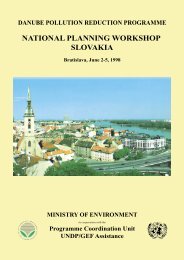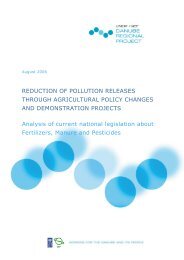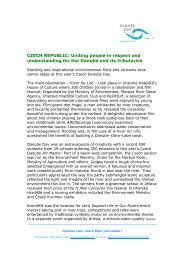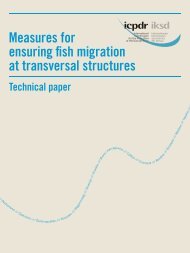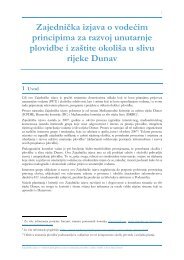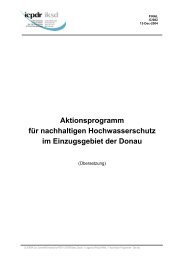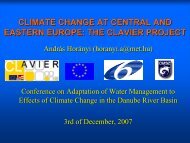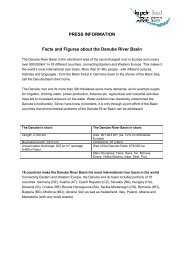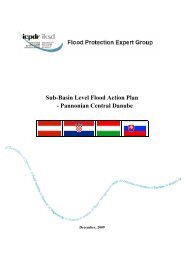Technical Reports Parts C,D - ICPDR
Technical Reports Parts C,D - ICPDR
Technical Reports Parts C,D - ICPDR
You also want an ePaper? Increase the reach of your titles
YUMPU automatically turns print PDFs into web optimized ePapers that Google loves.
<strong>Technical</strong> <strong>Reports</strong> – Part C: Water Quality 3<br />
1.2. Updating, Analysis and Validation of Water Quality Data<br />
Evident improvement of water quality in the Ukrainian section of the river Danube and its<br />
tributaries comparing to 80s reflects the economic difficulties in most of the countries of Central<br />
Europe as well as successes in introduction of harmonized environmental policies in all riparian<br />
countries of the Danube River basin.<br />
In the Ukrainian section of the Danube River Basin the water quality was monitored by following<br />
variables.<br />
Maximal content of suspended solids is observed during the summer seasons, and because the<br />
rivers are not covered with ice during winter periods. Small peaks in springtime are related to the<br />
spring flood events.<br />
Monitoring data are presented only for mineral species of nitrogen meanwhile the total nitrogen<br />
content including mineral and organic species have not been analyzed.<br />
Average annual concentration of the mineral species of nitrogen (sum of mineral species) in the<br />
Danube water varied between 1,39 and 0,51 mg/L with maximal concentrations 2,8 mg/L (Vylkovo<br />
and Izmail, 1996). By the monitoring data of the State Ecological Inspection the annual average<br />
nitrogen content was 9 mg/L. mostly as nitrates.<br />
It is evident that the portion of ammonia and nitrites decreased significantly during a last three<br />
years. The highest concentrations of nitrates were recorded in 1994 and 1995 reaching 13 -<br />
14mg/L. Usually the highest nitrogen content is accompanied by high water discharges.<br />
The content of mineral nitrogen species in the major Danube tributaries range between 0,10 and 6,0<br />
mg/L for Tisza River, 0,92 - 4,2 mg/L for Uzh River and 0,37 - 5,9 mg/L for Prut River. Long<br />
term trend of mineral nitrogen is reversibly related with water level. The prevailing concentrations<br />
are between 2,5 and 4,3mg/L with domination of nitrates and ammonium. The less abundant are<br />
nitrites.<br />
The monitoring data are presented only for total phosphorus (data of the hydrometeorological<br />
station) for a period 1994 -1996.<br />
Average concentration of total phosphorus in the Danube water varies between 0,14 - 0,47mg/L,<br />
with a range 0,06 - 1 mg/L. While in 1994 the changes of total phosphorus follow the changes of<br />
river discharges, later on its level became more stable. The phosphorus content in the major<br />
Danube tributaries is evidently lower than in Danube.<br />
The most comprehensive monitoring data exist for BOD5 that creates a good base for long-term<br />
trends assessment of organic pollution.<br />
Long term trend of BOD5 changes reveals the evident decrease of this variable. It can be explained<br />
by reduction of discharges of easily oxidized organic matter with industrial discharges due to<br />
decline of industrial output. Seasonal BOD5 variations in 1997 showed increase of readily<br />
available organic matter during high water periods.<br />
BOD5 is rather stable in the Danube tributaries: 2 - 5,3 mg/L for Tisza River (primarily 4 mg/L), 2<br />
- 5,7 mg/L with average 2,64 mg/L for Uzh, and 2 - 5,3 mg/L (average 2,65 - 3,75mg/L) for Prut.<br />
Hydrometeorological monitoring network in Ukraine has rather complete and long-term<br />
observations only for copper, chromium, and zinc. At the same time ecological inspections<br />
monitor copper, zinc, manganese, lead, nickel, chromium and iron. Long term trends in heavy<br />
metals contents are relatively stable for copper and chromium and slightly less stable for<br />
manganese and zinc. During the last two years the contents of zinc and manganese have increased<br />
significantly.



